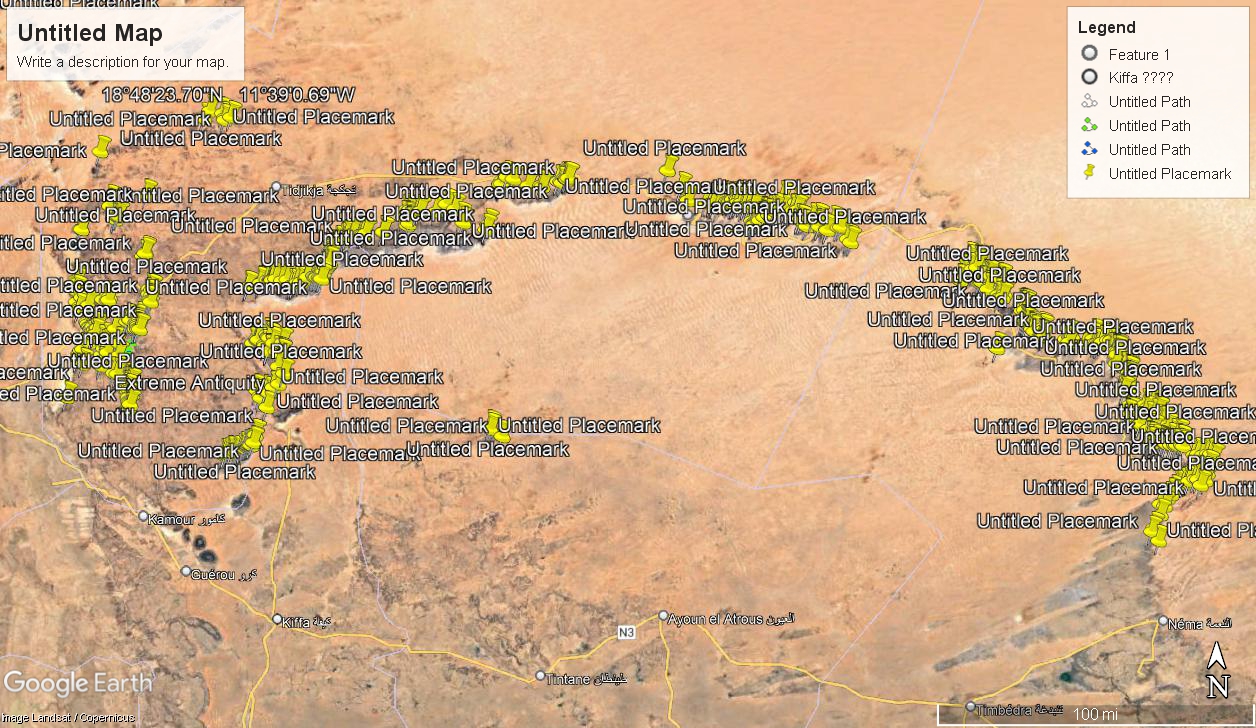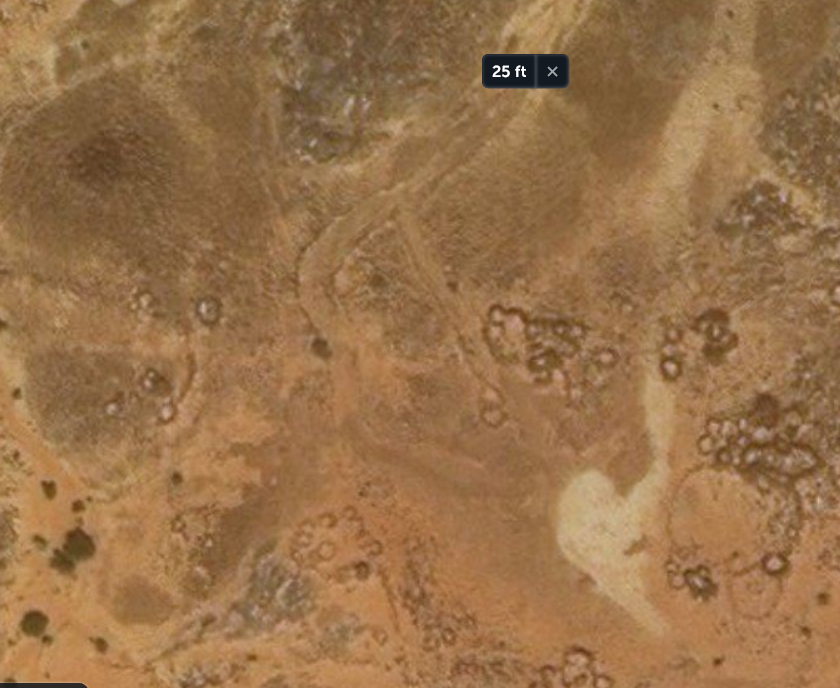It looks like you're using an Ad Blocker.
Please white-list or disable AboveTopSecret.com in your ad-blocking tool.
Thank you.
Some features of ATS will be disabled while you continue to use an ad-blocker.
share:
originally posted by: All Seeing Eye
a reply to: Hanslune
I demand nothing. And as far as "Blurry" your going to have to point to the offending image. Unscientific? Science, starts with the observation, not, the theory. Yes, I have my own personal opinion,, and it has the absolute same weight of everyone else's opinion, including yours.
But you ignore evidence and think your opinions are facts. Let me ask you? Do you think you have visual evidence - not opinion - that Atlantis IS located at the Richet?
Your problem is a inability to focus on the materials presented. You constantly go on tangents that have nothing to do with the debate. The images are not "Blurry", its your lack of perception.
No its you're inability (straight denial) that blurry images of a piece of terrain can act of evidence for a specific civilization being there - you seem to think your opinion is evidence. it isn't
You have to go excavate and do all the science stuff you are not interested in and until that is done all you got is opinion and enough for a hypothesis. "there is something there I wander what it is". In the real world you'd go and do a field survey and put in test pits and use lidar and ground penetrating radar.
archiqoo.com...
en.wikipedia.org...
Yes Holl did that the guy I suggested you talk to but you are to afraid to do so - why in the hell would you talk to a local expert when you can do it better with internet images? LOL
Again, this "Society" is under rated, even at admittedly 500 sites (More like 1000). It also neglects to mention the roads that are obvious, if one looks. Roads would transfer this culture, society, to Nation Status. But not one word about them....
You don't know what a " site" means in archaeology:
Site "Any place where human material remains are found; an area of human activity represented by material culture".
How old do you think motorized vehicle roads are?
One stone tool constitutes a site, a habitation that lasted two-thousand years and has three thousands individual items in it is considered a 'site'. 500 isn't an impressive number, The Grand Canyon has 4,300 and its growing rapidly.
It is not I who refuses to see what is there. And willful blindness, is just plane silly!
See what 'ASE' ? A place where human were, no idea of the date and its the date and context which is important - and you cannot tell that from an image.
YOU WILL ALWAYS, ALWAYS find human remains in any place where man can live and has for hundreds of thousands of years - why do you have such difficulty with that idea?
If I show you a picture of the Capital of Iceland is that evidence that Atlantis located there?
edit on 28/5/22 by Hanslune because: (no reason given)
a reply to: Hanslune
Again, please point to the blurry image your having trouble with. We can debate that particular image. You can tell me what you see, And Ill offer my view. Pick out the worst of the worst. If you win the debate, Ill delete the image.
You ever hear of Satellite Archeology? Also known as Space Archeology.
Satellites are transforming how archaeologists study the past
All I can do is locate possible sites. You can take my opinion or leave it on the side of the road. But the one thing you cant do is stuff my mind in a box, it wont fit.
As for your local expert (brother?), send him the link to this thread. If he wishes to discuss one of the images Ill be more than happy to. Ill listen to anyone's point of view, but I reserve the right to make my own mind up. As I allow the readers of this thread to do the same.
You say my opinion is wrong. Okay. Your opinion. Now, try to limit yourself to discussing the images. Point to the blurry one.
Explain to me how this isn't a extinct river.
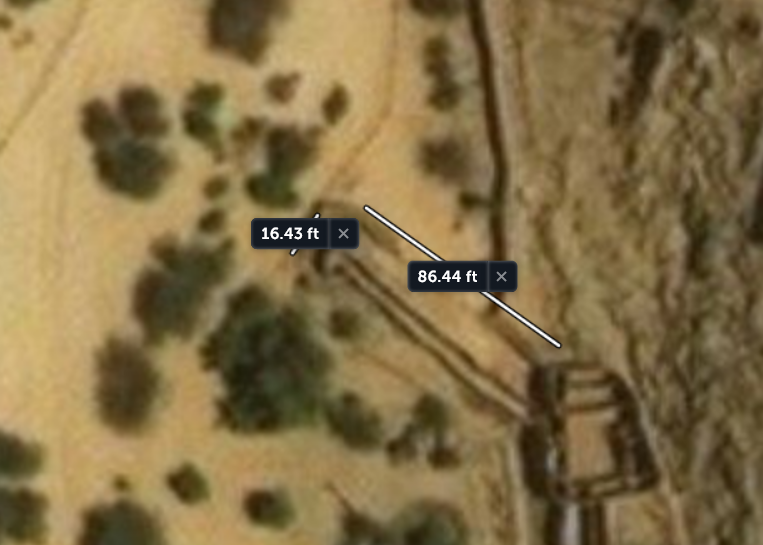
No its you're inability (straight denial) that blurry images of a piece of terrain can act of evidence for a specific civilization being there - you seem to think your opinion is evidence. it isn't
Again, please point to the blurry image your having trouble with. We can debate that particular image. You can tell me what you see, And Ill offer my view. Pick out the worst of the worst. If you win the debate, Ill delete the image.
You ever hear of Satellite Archeology? Also known as Space Archeology.
Satellites are transforming how archaeologists study the past
All I can do is locate possible sites. You can take my opinion or leave it on the side of the road. But the one thing you cant do is stuff my mind in a box, it wont fit.
As for your local expert (brother?), send him the link to this thread. If he wishes to discuss one of the images Ill be more than happy to. Ill listen to anyone's point of view, but I reserve the right to make my own mind up. As I allow the readers of this thread to do the same.
You say my opinion is wrong. Okay. Your opinion. Now, try to limit yourself to discussing the images. Point to the blurry one.
Explain to me how this isn't a extinct river.

originally posted by: Hanslune
originally posted by: bloodymarvelous
The point of the story is to show Athens with its government was superior...
It didn't the area of Attica became inhabited around 5000 BCE, archaeology shows some HG groups may have been around earlier. There were no Greeks, no Athenians or any organized group in that part of the world at that time.
That is why believers attack the dating.
That is a good point, unless the people, like so many others have, migrated from somewhere, to somewhere.
Which is why Plato being wrong about some things is NOT evidence that he made the story up.
It's evidence that his knowledge was limited, and contained some amount of speculation.
...and this brings us to the ever popular, 'determination' listing of all facts mentioned by Plato and then picking which ones were real and which ones are not.
All Atlantologists arrive at this point: mostly they reject just enough so they can place Atlantis pretty much everywhere in the world and at any time they like.
So, in your estimation which of his 'facts' are real and which are not?
I'm just expecting something like a 70% accuracy rate.
Sort of like how with the story of Troy, I don't actually expect to discover Penthisilia of the Amazons taking to the battlefield (or even evidence of the Amazons being real), despite that being mentioned by Homer.
I'm only expecting to find a notable city that lived on in legend after it met its end, perhaps connected to a natural catastrophe, and having some kind of naval presence.
For it to be the Richat, I think the people telling the legend must have believed Mauritania to have been located (at one time) in the Atlantic Ocean. There would be some other legend about how all the water dried up and it became a desert. But Solon only hears the first legend, and not the second one.
That's one possibility.
And to be clear: in suggesting this, I am NOT suggesting Mauritania ever actually was in the Atlantic. Just saying that maybe Libyan legend tellers *believed* it had been.
Perhaps the city and its ruins were as much a mystery to them as to anyone else, and they had little or no direct knowledge of its nature, but made up stories to explain how such a blob of total destruction could be found so far from any other source of civilization.
My contention is against the idea of Plato making it up. I have too much respect for Plato to think that. I'm inclined to think Solon really heard a legend. Does that mean the legend was real? ....... not exactly....
edit on 29-5-2022 by bloodymarvelous
because: (no reason given)
a reply to: bloodymarvelous
Many may have a misconception as to the educational level of the common man. If he had any at all it would be way beyond the norm, after all, we are talking about people that were considered slaves for the most part. Information was held close to the rulers and their inner circles.
As to what was known about the world they lived in most commonly was of their local surroundings. Not about foreign lands. There were no schools to be sent to to lean about that world. And at most, could only repeat what they were told, and again, if anything.
I'm pretty certain the difference between a inland sea and a ocean was not understood. A large body of water was, as far as anyone could know back then a ocean. Especially if that body of water was 400 miles by 200 miles. And I doubt few walked the perimeter to measure it. If you heard of a large city, country on the other side of that body of water, you might consider it a different continent. And for that myth to be passed down generation after generation, based on facts they could never confirm, is what Plato was given.
It has taken some time to justify and consider the location and size of the ancient, extinct inland sea of Maghreb. At the height of the African Humid Period, it could have been 3 times its size than is depicted. And it would be very possible to consider the lands on the opposite side a continent, or large island, in a ocean.
And as a reminder, Plato's version is only half of the story, so, anything is possible. It could have discussed the gods and their actions, because after all, that is where the story ended,
There is just something wrong when someone demands a half story be viewed as a whole story. As the saying goes, a half truth, is a whole lie. And in that may be the reason we are only allowed the first half, to sow confusion, and possibly diversion into the debate.
To circumvent this, i believe contrived ignorance, we must attempt to locate the location of the Ringed City, and investigate any evidence found, that might fill in the vacuum created by the missing part. And for me, I believe we have. But there are those who demand solid archeological evidence, demanding it be held exactly to what Plato stated, when they know full well, much of the city was destroyed and much of the evidence was washed away, plus, excavations in the area are being forbidden unless conducted by Academia (UNESCO). But on the other hand, the destruction was not complete and only focused on the center island. Much, is still there, buried in dried mud. Plato described the Ringed City with great detail, and the Richat is a virtual match.
The evidence is mounting.
Water settles into low lying areas first, then, will find its way to another lower level, until it reached the ocean.
The possible extent of the Meghreb Inland Sea. It could have looked like a ocean to those who didn't understand the differences. The low lying areas involved, are at least 3 times larger than what is being depicted.
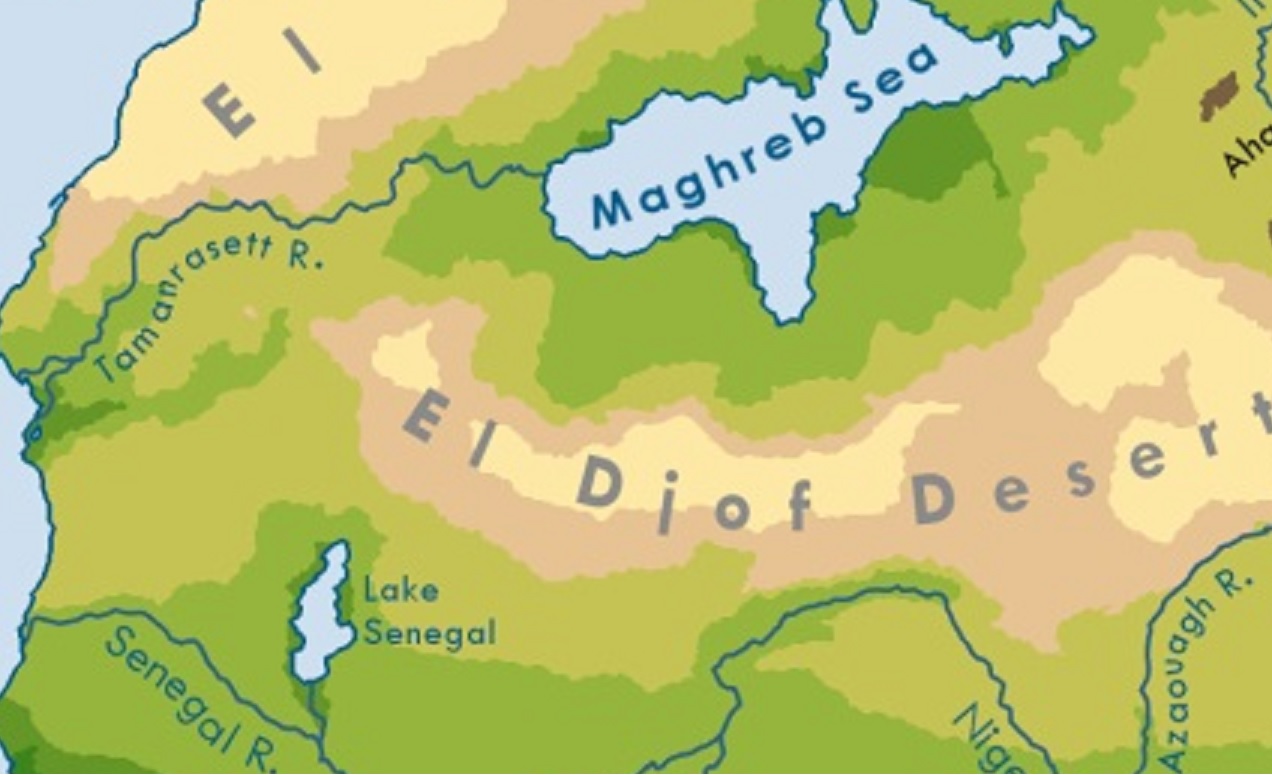
For it to be the Richat, I think the people telling the legend must have believed Mauritania to have been located (at one time) in the Atlantic Ocean. There would be some other legend about how all the water dried up and it became a desert. But Solon only hears the first legend, and not the second one.
Many may have a misconception as to the educational level of the common man. If he had any at all it would be way beyond the norm, after all, we are talking about people that were considered slaves for the most part. Information was held close to the rulers and their inner circles.
As to what was known about the world they lived in most commonly was of their local surroundings. Not about foreign lands. There were no schools to be sent to to lean about that world. And at most, could only repeat what they were told, and again, if anything.
I'm pretty certain the difference between a inland sea and a ocean was not understood. A large body of water was, as far as anyone could know back then a ocean. Especially if that body of water was 400 miles by 200 miles. And I doubt few walked the perimeter to measure it. If you heard of a large city, country on the other side of that body of water, you might consider it a different continent. And for that myth to be passed down generation after generation, based on facts they could never confirm, is what Plato was given.
It has taken some time to justify and consider the location and size of the ancient, extinct inland sea of Maghreb. At the height of the African Humid Period, it could have been 3 times its size than is depicted. And it would be very possible to consider the lands on the opposite side a continent, or large island, in a ocean.
And as a reminder, Plato's version is only half of the story, so, anything is possible. It could have discussed the gods and their actions, because after all, that is where the story ended,
Zeus, the god of gods, who rules according to law, and is able to see into such things, perceiving that an honourable race was in a woeful plight, and wanting to inflict punishment on them, that they might be chastened and improve, collected all the gods into their most holy habitation, which, being placed in the centre of the world, beholds all created things. And when he had called them together, he spake as follows-* The rest of the Dialogue of Critias has been lost.
There is just something wrong when someone demands a half story be viewed as a whole story. As the saying goes, a half truth, is a whole lie. And in that may be the reason we are only allowed the first half, to sow confusion, and possibly diversion into the debate.
To circumvent this, i believe contrived ignorance, we must attempt to locate the location of the Ringed City, and investigate any evidence found, that might fill in the vacuum created by the missing part. And for me, I believe we have. But there are those who demand solid archeological evidence, demanding it be held exactly to what Plato stated, when they know full well, much of the city was destroyed and much of the evidence was washed away, plus, excavations in the area are being forbidden unless conducted by Academia (UNESCO). But on the other hand, the destruction was not complete and only focused on the center island. Much, is still there, buried in dried mud. Plato described the Ringed City with great detail, and the Richat is a virtual match.
The evidence is mounting.
Water settles into low lying areas first, then, will find its way to another lower level, until it reached the ocean.
The possible extent of the Meghreb Inland Sea. It could have looked like a ocean to those who didn't understand the differences. The low lying areas involved, are at least 3 times larger than what is being depicted.

originally posted by: bloodymarvelous
It didn't the area of Attica became inhabited around 5000 BCE, archaeology shows some HG groups may have been around earlier. There were no Greeks, no Athenians or any organized group in that part of the world at that time.
That is why believers attack the dating.
That is a good point, unless the people, like so many others have, migrated from somewhere, to somewhere.
What is that suppose to mean?
I'm just expecting something like a 70% accuracy rate.
Sort of like how with the story of Troy, I don't actually expect to discover Penthisilia of the Amazons taking to the battlefield (or even evidence of the Amazons being real), despite that being mentioned by Homer.
I'm only expecting to find a notable city that lived on in legend after it met its end, perhaps connected to a natural catastrophe, and having some kind of naval presence.
When Frank Calvert found Troy and Schliemann excavated. While that site is around the correct date we cannot find the Greek camp. Documents in the Hittite archives seems to imply it was the place. So the place probably existed but the story about in the Iliad and Odyssey are mainly ficitional.
For it to be the Richat, I think the people telling the legend must have believed Mauritania to have been located (at one time) in the Atlantic Ocean. There would be some other legend about how all the water dried up and it became a desert. But Solon only hears the first legend, and not the second one.
Or Plato placed his fictional place at the edge of the world known to the Greeks
That's one possibility.
And to be clear: in suggesting this, I am NOT suggesting Mauritania ever actually was in the Atlantic. Just saying that maybe Libyan legend tellers *believed* it had been.
Perhaps the city and its ruins were as much a mystery to them as to anyone else, and they had little or no direct knowledge of its nature, but made up stories to explain how such a blob of total destruction could be found so far from any other source of civilization.
You are assuming the ruins exist but based on current evidence there is no city there from 9,000 years before Plato
My contention is against the idea of Plato making it up. I have too much respect for Plato to think that.I'm inclined to think Solon really heard a legend. Does that mean the legend was real? ....... not exactly....
You can certainly believe that if you want but the evidence points against it. The biggest problem of course is no sign of said place in geology, archaeology or history. Atlantean pottery (even if ti was before pottery became common) and stone tools should be all over the place. They aren't while at the same time we do find stone tools all over Europe, Asia and Africa associated with cultures there from before, during and after this period.
edit on 29/5/22 by Hanslune because: (no reason given)
originally posted by: All Seeing Eye
To circumvent this, i believe contrived ignorance, we must attempt to locate the location of the Ringed City, and investigate any evidence found, that might fill in the vacuum created by the missing part. And for me, I believe we have. But there are those who demand solid archeological evidence, demanding it be held exactly to what Plato stated, when they know full well, much of the city was destroyed and much of the evidence was washed away, plus, excavations in the area are being forbidden unless conducted by Academia (UNESCO). But on the other hand, the destruction was not complete and only focused on the center island. Much, is still there, buried in dried mud. Plato described the Ringed City with great detail, and the Richat is a virtual match.
Almost all nations do not let amateurs do digs, one they tend to destroy the site and don't record it. Long experience has shown that the best results come from well known organizations usually academic ones using qualified archaeologists and other specialists (geologists, linguists, botanist, pottery experts, etc.,). This isn't some evil conspiracy by UNESCO but common sense regulation pretty much used world wide.
The Richat is not a match if it show us line by line with what Plato said that makes you believe that? One Plato said it was built and the Richat is natural.....
The evidence is mounting.
Lol, no it isn't - this is common cry of those who have nothing to support a concept lacking in support. this usually means they need to belief harder to keep the lack of supporting evidence from 'sinking their boat'.
The Maghreb lakes looks to be in a different location than the ring
www.nationsonline.org...
www.earthlymission.com...
originally posted by: bloodymarvelous
I'm only expecting to find a notable city that lived on in legend after it met its end, perhaps connected to a natural catastrophe, and having some kind of naval presence.
No, from the onset you are first assuming a legend. A legend that still existed in Solon's day but has since been lost.
There is not a single whit of evidence that there ever was such a legend, so back to square one.
Harte
edit on 5/29/2022 by Harte because: of the wonderful things he does!
originally posted by: bloodymarvelous
My contention is against the idea of Plato making it up. I have too much respect for Plato to think that.
Most people have a great deal of respect for Plato, myself included.
I would even venture to say that I have a great deal more respect for Plato than you do, since I have read all of his dialogues several times and several of them tens of times and you apparently have not.
In the Republic (a Dialogue about a made-up society,) Plato espouses the "Noble Lie," and says quite clearly that fables are the way to go when educating youths. Plato made stuff up all the time.
All. The. Time.
Please try and find enough respect for Plato to actually study Plato, at least a little bit.
Harte
edit on 5/29/2022 by Harte because: of the wonderful things he does!
originally posted by: Hanslune
originally posted by: bloodymarvelous
It didn't the area of Attica became inhabited around 5000 BCE, archaeology shows some HG groups may have been around earlier. There were no Greeks, no Athenians or any organized group in that part of the world at that time.
That is why believers attack the dating.
That is a good point, unless the people, like so many others have, migrated from somewhere, to somewhere.
What is that suppose to mean?
Sort of like how the English aren't the original inhabitants of the British Isles.
Linguistically the Angles existed a good while before they left Germany.
I'm just expecting something like a 70% accuracy rate.
Sort of like how with the story of Troy, I don't actually expect to discover Penthisilia of the Amazons taking to the battlefield (or even evidence of the Amazons being real), despite that being mentioned by Homer.
I'm only expecting to find a notable city that lived on in legend after it met its end, perhaps connected to a natural catastrophe, and having some kind of naval presence.
When Frank Calvert found Troy and Schliemann excavated. While that site is around the correct date we cannot find the Greek camp. Documents in the Hittite archives seems to imply it was the place. So the place probably existed but the story about in the Iliad and Odyssey are mainly ficitional.
I'm not expecting the legend of Atlantis to turn out to be much better.
We're talking about a story received at least three stages down the grapevine here. Troy was a widely told and retold story throughout its region.
Atlantis made it to Plato in 4 or 5 stages.
Stage 1 : An oral tradition gets written down by Egyptian/(possibly Libyan) priests.
Stage 2: They tell Solon.
Stage 3: Solon tells it to the guy Plato/Critias hears it from.
Stage 4: Critias either tells Plato, or Plato was Critias.
Stage 5: Incomplete texts containing this dialogue make their way to the present.
If the main body of the tale made it to us, that is enough for me at this point.
For it to be the Richat, I think the people telling the legend must have believed Mauritania to have been located (at one time) in the Atlantic Ocean. There would be some other legend about how all the water dried up and it became a desert. But Solon only hears the first legend, and not the second one.
Or Plato placed his fictional place at the edge of the world known to the Greeks
That's one possibility.
And to be clear: in suggesting this, I am NOT suggesting Mauritania ever actually was in the Atlantic. Just saying that maybe Libyan legend tellers *believed* it had been.
Perhaps the city and its ruins were as much a mystery to them as to anyone else, and they had little or no direct knowledge of its nature, but made up stories to explain how such a blob of total destruction could be found so far from any other source of civilization.
You are assuming the ruins exist but based on current evidence there is no city there from 9,000 years before Plato
In this case, as a Libyan myth, it would have been an oral tradition carried around by herds people traveling the Green Sahara, who later settled somewhere they could continue to survive after the place turned to desert.
I'm not going to deny that the Libyan herdspeople made the myth up. I just don't think Plato made it up.
My contention is against the idea of Plato making it up. I have too much respect for Plato to think that.I'm inclined to think Solon really heard a legend. Does that mean the legend was real? ....... not exactly....
You can certainly believe that if you want but the evidence points against it. The biggest problem of course is no sign of said place in geology, archaeology or history. Atlantean pottery (even if ti was before pottery became common) and stone tools should be all over the place. They aren't while at the same time we do find stone tools all over Europe, Asia and Africa associated with cultures there from before, during and after this period.
I'm finding the satellite images compelling. Especially the one that looks like a river dock. There is no way a river dock could be a more modern ruin.
I think some nomads were traveling out in the middle of the Mauritanian desert and came across city ruins of a scale that was simply impossible, given the environment.
Such a curiousity was so interesting that they had to continue investigating. They talked about it. Others came to see it. People began to speculate as to how it was possible, which added flesh to the legend. (And those speculating were unaware the area had once been the Green Sahara.)
The idea that they were living in the bones of a fallen great civilization gave them pride, and so they began to embellish some of the details, making the lost city sound mightier than it had been.
originally posted by: Hanslune
The Richat is not a match if it show us line by line with what Plato said that makes you believe that? One Plato said it was built and the Richat is natural.....
That is factually incorrect.
The text specifically states that Poseidon created the rings. And then the humans who lived there cut channels through the rings to connect the water ways.
The cutting of the channels is all the humans did. The rings themselves were created by a god (IE. a force of nature.)
a reply to: bloodymarvelous
If, it turns out to be a boat dock that would lock its creation in between 12,500Bc to 3550bc. After all, there isn't much use for boats, in a desert. And to support a river with running water is the no name ruins to the east that sit on a extinct river. The Ruin makes no logical sense unless there was water in that river.
Who knows, maybe Plato's 9000 years before is accurate. It might be the time the Ringed City, was "Instituted", founded. And its end date would coincide with the end of the AHP, 3550bc.
If someone considered Poseidon the creator god(mother nature), then yes they would consider him the creator of the rings. Today, we know better. Good point.
I'm finding the satellite images compelling. Especially the one that looks like a river dock. There is no way a river dock could be a more modern ruin.
If, it turns out to be a boat dock that would lock its creation in between 12,500Bc to 3550bc. After all, there isn't much use for boats, in a desert. And to support a river with running water is the no name ruins to the east that sit on a extinct river. The Ruin makes no logical sense unless there was water in that river.
Who knows, maybe Plato's 9000 years before is accurate. It might be the time the Ringed City, was "Instituted", founded. And its end date would coincide with the end of the AHP, 3550bc.
If someone considered Poseidon the creator god(mother nature), then yes they would consider him the creator of the rings. Today, we know better. Good point.
originally posted by: bloodymarvelous
That is factually incorrect.
The text specifically states that Poseidon created the rings. And then the humans who lived there cut channels through the rings to connect the water ways.
The cutting of the channels is all the humans did. The rings themselves were created by a god (IE. a force of nature.)
The text specifically states:
The portion of the Island of Atlantis that was ringed was not the entire island, but nonetheless, the ringed portion had a radius of 19.5 stadia (39 stadia diameter.)
That is a slightly less than 4.5 miles in diameter.
The Richat structure is 28 miles wide.
There are three (approximately) circular rings associated with the Richat.
The text specifically states that there are two circular (land) rings around the central island on Atlantis and the third "ring" portion conformed to the shape of the island (which was not described as circular.)
Though none of the rings of the Richat are perfectly continuous, there are no openings in them that align from ring to ring to ring.
The text specifically states that channels were cut through the (land) rings of Atlantis allowing triremes to pass through.
The Richat structure is approximately 310 miles from the Atlantic coast and is over 1100 feet above sea level.
The text specifically states Atlantis had a 300-foot wide, 50 stadia (5.6 miles) long canal that went perfectly straight from the outermost (water) ring to the Atlantic Ocean.
Harte
originally posted by: Harte
originally posted by: bloodymarvelous
That is factually incorrect.
The text specifically states that Poseidon created the rings. And then the humans who lived there cut channels through the rings to connect the water ways.
The cutting of the channels is all the humans did. The rings themselves were created by a god (IE. a force of nature.)
The text specifically states:
The portion of the Island of Atlantis that was ringed was not the entire island, but nonetheless, the ringed portion had a radius of 19.5 stadia (39 stadia diameter.)
That is a slightly less than 4.5 miles in diameter.
The Richat structure is 28 miles wide.
There are three (approximately) circular rings associated with the Richat.
The text specifically states that there are two circular (land) rings around the central island on Atlantis and the third "ring" portion conformed to the shape of the island (which was not described as circular.)
Though none of the rings of the Richat are perfectly continuous, there are no openings in them that align from ring to ring to ring.
The text specifically states that channels were cut through the (land) rings of Atlantis allowing triremes to pass through.
The Richat structure is approximately 310 miles from the Atlantic coast and is over 1100 feet above sea level.
The text specifically states Atlantis had a 300-foot wide, 50 stadia (5.6 miles) long canal that went perfectly straight from the outermost (water) ring to the Atlantic Ocean.
Harte
Yep but this doesn't agree with what some want to believe and so it will be ignored. Admit it Harte you said the above because UNESCO told you to. Chuckle!!!
originally posted by: Harte
originally posted by: Hanslune
If I show you a picture of the Capital of Iceland is that evidence that Atlantis located there?
Now Hans, no need for sarcasm.
OBVIOUSLY, that wouldn't be evidence for Atlantis.
It would be evidence for Hyperborea.
Harte
Yes and Robert E. Howard wrote the history of those lands

hanslune.imgur.com...
edit on 30/5/22 by Hanslune because: (no reason given)
originally posted by: All Seeing Eye
a reply to: Hanslune
Again, please point to the blurry image your having trouble with. We can debate that particular image. You can tell me what you see, And Ill offer my view. Pick out the worst of the worst. If you win the debate, Ill delete the image.
Your last one was clear as day wasn't it? LOL
Blurry
Explain to me how this isn't a extinct river.
What the blurry thing?
So instead of answering the expert a detailed question(s) about archaeology in Mauritania you invited him to conspiracy board - good move dude.........
Now you can answer all my questions you've run away from - how about them?
OR
Do you want to hide behind more blurry images?
I'll repost all the questions you've run from later.
edit on 30/5/22 by Hanslune because: (no reason given)
a reply to: Hanslune
Maybe you don't understand Satellite photography. First, the camera that took the image is approx 3200 miles up. Dam good camera if you ask me. Though I'm certain the CIA would have better clarity, but to date, they have not offered me their services.
Satellites for observing Earth use a special orbit referred to as a Sun-synchronous LEO. The properties of these orbits enable a satellite to view Earth with the Sun in exactly the same position day after day. Satellites like NASA's Landsat series monitor environmental changes — for example, vegetation growth. For these observations to be meaningful, each image must have the same illumination. Such orbits are also great for surveillance satellites, as one can select lighting conditions best suited for a given target.
If you need 4k resolution I would suggest you get that local "Expert" to put up a DJI drone and click away.
The object in this image makes no sense being in a desert wadi. And I would assume all those looking at it from ground level would see only a odd 6 ft tall wall. And unless the Archeologists in the past also studied ancient history, or the ancient weather, it would never register.
The early history of Ouadane is uncertain
The above is a open door as to when Quadane was established. Having suspected water related objects in the area would now set the date as being within the African Humid Period. 12,000 - 3500 bc. But this object also brings into possibility of Boats in this area, during that time frame.
To put it into its proper perspective here is a higher level image showing the suspected boat dock, with a island to the north. The island has ruins on it as well.
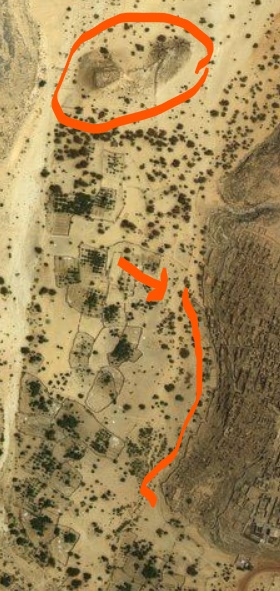
The above is only true, during the African Humid Period, and a time before the river dried up.
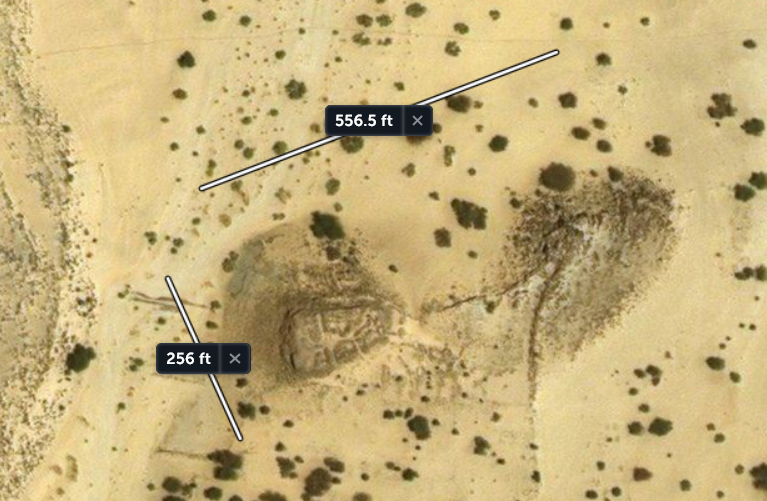

And to the Southwest of the Eye is another abandon ruin, on the suspected shores of a extinct river. No information at all concerning this ruin.
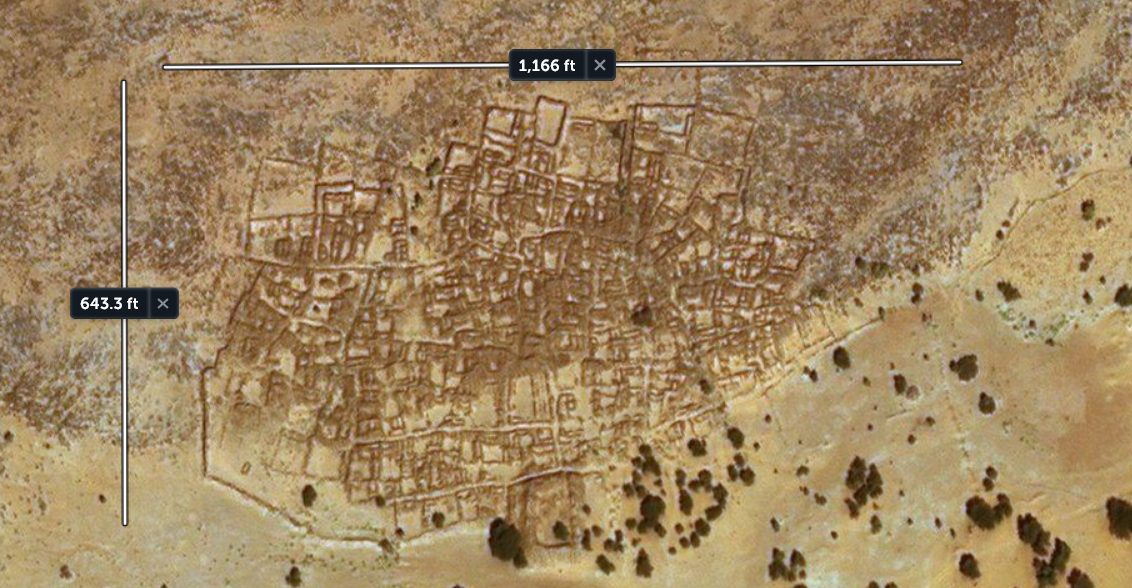
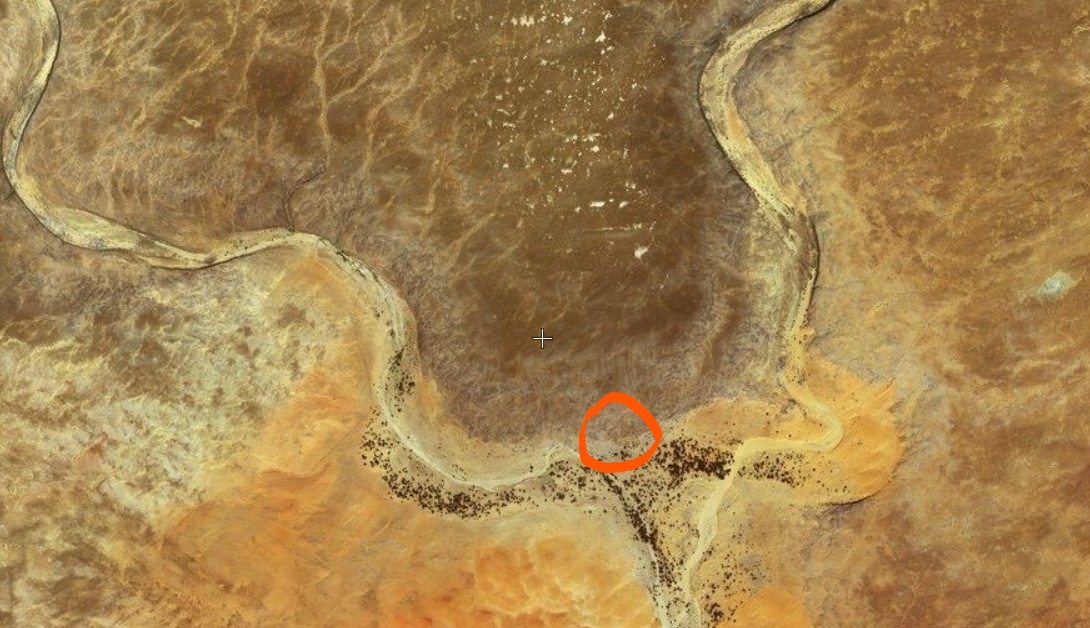
3 water related features that would logically place the date to pre 3500bc.
If your questions go too far astray of the subject matter, they may go unanswered. I'm certain your interested in keeping the thread from "Drifting".
What the blurry thing?
Maybe you don't understand Satellite photography. First, the camera that took the image is approx 3200 miles up. Dam good camera if you ask me. Though I'm certain the CIA would have better clarity, but to date, they have not offered me their services.
Satellites for observing Earth use a special orbit referred to as a Sun-synchronous LEO. The properties of these orbits enable a satellite to view Earth with the Sun in exactly the same position day after day. Satellites like NASA's Landsat series monitor environmental changes — for example, vegetation growth. For these observations to be meaningful, each image must have the same illumination. Such orbits are also great for surveillance satellites, as one can select lighting conditions best suited for a given target.
If you need 4k resolution I would suggest you get that local "Expert" to put up a DJI drone and click away.
The object in this image makes no sense being in a desert wadi. And I would assume all those looking at it from ground level would see only a odd 6 ft tall wall. And unless the Archeologists in the past also studied ancient history, or the ancient weather, it would never register.
The early history of Ouadane is uncertain
The above is a open door as to when Quadane was established. Having suspected water related objects in the area would now set the date as being within the African Humid Period. 12,000 - 3500 bc. But this object also brings into possibility of Boats in this area, during that time frame.
To put it into its proper perspective here is a higher level image showing the suspected boat dock, with a island to the north. The island has ruins on it as well.

The above is only true, during the African Humid Period, and a time before the river dried up.


And to the Southwest of the Eye is another abandon ruin, on the suspected shores of a extinct river. No information at all concerning this ruin.


3 water related features that would logically place the date to pre 3500bc.
If your questions go too far astray of the subject matter, they may go unanswered. I'm certain your interested in keeping the thread from "Drifting".
originally posted by: All Seeing Eye
a reply to: Hanslune
What the blurry thing?
If your questions go too far astray of the subject matter, they may go unanswered. I'm certain your interested in keeping the thread from "Drifting".
In other words if it points to you being wrong you are going ti ignore it - yeah we know that. So continue on with blurry images and FIND stuff where it should be and make up stories about it!!!! WHEEEEE fringe time - throw out the evidence and let loose the make believe!!!!
Sorry eye but what you are doing is pure fringe.
a reply to: Hanslune
I'm going to accept your Complement, I'm sure it comes from the heart
Fringe science
10 Ways Fringe Science Improved The World
I'm going to accept your Complement, I'm sure it comes from the heart
Friedlander suggests that fringe science is necessary so that mainstream science will not atrophy. Scientists must evaluate the plausibility of each new fringe claim, and certain fringe discoveries "will later graduate into the ranks of accepted" — while others "will never receive confirmation".[2]: 173
Michael W. Friedlander has suggested some guidelines for responding to fringe science, which, he argues, is a more difficult problem[2]: 174 than scientific misconduct. His suggested methods include impeccable accuracy, checking cited sources, not overstating orthodox science, thorough understanding of the Wegener continental drift example, examples of orthodox science investigating radical proposals, and prepared examples of errors from fringe scientists.[2]: 178-9
Fringe science
There have always been people pursuing studies that were scoffed at by the mainstream scientific community, largely for good reason. However, that doesn’t mean that pseudoscience has no merit whatsoever. Even if the general idea of the discipline is bunk, the pursuit of these nonsensical ideas sometimes leads to something useful to the scientific community and even the world at large
10 Ways Fringe Science Improved The World
a reply to: All Seeing Eye
Except Harte has quoted Plato concerning the size of Atlantis and it was described as more on the scale of ancient Athens itself than the Richat structure. There are other better candidates that might have inspired Plato. Porlock UK actually has submerged forests. The area was several miles inland until the sea level in the Bristol Channel rose about 7000 to 8000 years ago.
Something important would have had to have been recorded in the Sahara other than the known hunter-gatherer tribal activity for Plato to take interest.
Thank you for the thread though, I thought there might be more than anecdotal evidence that Plato's duality was inspired by the Egyptian eye of Ra-Horus myth. The eye of the Sahara certainly might have looked like the eye of Horus during the AHP when there was more vegetation in the flooded valleys of those circles. Apparently just hunter gatherer types there that couldn't see it.
3 water related features that would logically place the date to pre 3500bc.
Except Harte has quoted Plato concerning the size of Atlantis and it was described as more on the scale of ancient Athens itself than the Richat structure. There are other better candidates that might have inspired Plato. Porlock UK actually has submerged forests. The area was several miles inland until the sea level in the Bristol Channel rose about 7000 to 8000 years ago.
Something important would have had to have been recorded in the Sahara other than the known hunter-gatherer tribal activity for Plato to take interest.
Thank you for the thread though, I thought there might be more than anecdotal evidence that Plato's duality was inspired by the Egyptian eye of Ra-Horus myth. The eye of the Sahara certainly might have looked like the eye of Horus during the AHP when there was more vegetation in the flooded valleys of those circles. Apparently just hunter gatherer types there that couldn't see it.
originally posted by: fromunclexcommunicate
a reply to: All Seeing Eye
The eye of the Sahara certainly might have looked like the eye of Horus during the AHP when there was more vegetation in the flooded valleys of those circles. Apparently just hunter gatherer types there that couldn't see it.
Given the size of it I don't anyone would have been able to determine what it looked like until flight and especially space flight.
new topics
-
iPhone Microphone Being Accessed by Unknown App
Rant: 1 hours ago -
Democrats send letter to Biden urging him to ratify Equal Rights Amendment
US Political Madness: 7 hours ago
top topics
-
Democrats send letter to Biden urging him to ratify Equal Rights Amendment
US Political Madness: 7 hours ago, 2 flags -
iPhone Microphone Being Accessed by Unknown App
Rant: 1 hours ago, 2 flags
active topics
-
George Stephanopoulos and ABC agree to pay $15 million to settle Trump defamation suit
Mainstream News • 26 • : Lazy88 -
Mood Music Part VI
Music • 3736 • : Hellmutt -
Only two Navy destroyers currently operational as fleet size hits record low
Military Projects • 25 • : Oldcarpy2 -
-@TH3WH17ERABB17- -Q- ---TIME TO SHOW THE WORLD--- -Part- --44--
Dissecting Disinformation • 3716 • : RelSciHistItSufi -
Democrats send letter to Biden urging him to ratify Equal Rights Amendment
US Political Madness • 4 • : VictorVonDoom -
Light from Space Might Be Travelling Instantaneously
Space Exploration • 30 • : cooperton -
Drones everywhere in New Jersey ---and Elsewhere Master Thread
Aliens and UFOs • 175 • : nugget1 -
iPhone Microphone Being Accessed by Unknown App
Rant • 0 • : Roma1927 -
The Acronym Game .. Pt.4
General Chit Chat • 1017 • : JJproductions -
Defending the need for adherence to Old Testament commandments under the new covenant of Christ
Conspiracies in Religions • 27 • : FlyersFan

